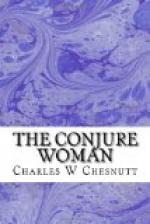of the Indian conjurer. In the old plantation
days they flourished vigorously, though discouraged
by the “great house,” and their potency
was well established among the blacks and the poorer
whites. Education, however, has thrown the ban
of disrepute upon witchcraft and conjuration.
The stern frown of the preacher, who looks upon superstition
as the ally of the Evil One; the scornful sneer of
the teacher, who sees in it a part of the livery of
bondage, have driven this quaint combination of ancestral
traditions to the remote chimney corners of old black
aunties, from which it is difficult for the stranger
to unearth them. Mr. Harris, in his Uncle Remus
stories, has, with fine literary discrimination, collected
and put into pleasing and enduring form, the plantation
stories which dealt with animal lore, but so little
attention has been paid to those dealing with so-called
conjuration, that they seem in a fair way to disappear,
without leaving a trace behind. The loss may not
be very great, but these vanishing traditions might
furnish valuable data for the sociologist, in the
future study of racial development. In writing,
a few years ago, the volume entitled The Conjure
Woman, I suspect that I was more influenced by
the literary value of the material than by its sociological
bearing, and therefore took, or thought I did, considerable
liberty with my subject. Imagination, however,
can only act upon data—one must have somewhere
in his consciousness the ideas which he puts together
to form a connected whole. Creative talent, of
whatever grade, is, in the last analysis, only the
power of rearrangement—there is nothing
new under the sun. I was the more firmly impressed
with this thought after I had interviewed half a dozen
old women, and a genuine “conjure doctor;”
for I discovered that the brilliant touches, due, I
had thought, to my own imagination, were after all
but dormant ideas, lodged in my childish mind by old
Aunt This and old Uncle That, and awaiting only the
spur of imagination to bring them again to the surface.
For instance, in the story, “Hot-foot Hannibal,”
there figures a conjure doll with pepper feet.
Those pepper feet I regarded as peculiarly my own,
a purely original creation. I heard, only the
other day, in North Carolina, of the consternation
struck to the heart of a certain dark individual,
upon finding upon his doorstep a rabbit’s foot—a
good omen in itself perhaps—to which a malign
influence had been imparted by tying to one end of
it, in the form of a cross, two small pods of red
pepper!
Most of the delusions connected with this belief in conjuration grow out of mere lack of enlightenment. As primeval men saw a personality behind every natural phenomenon, and found a god or a devil in wind, rain, and hail, in lightning, and in storm, so the untaught man or woman who is assailed by an unusual ache or pain, some strenuous symptom of serious physical disorder, is prompt to accept the suggestion, which tradition approves, that some evil influence is behind his discomfort; and what more natural than to conclude that some rival in business or in love has set this force in motion?




